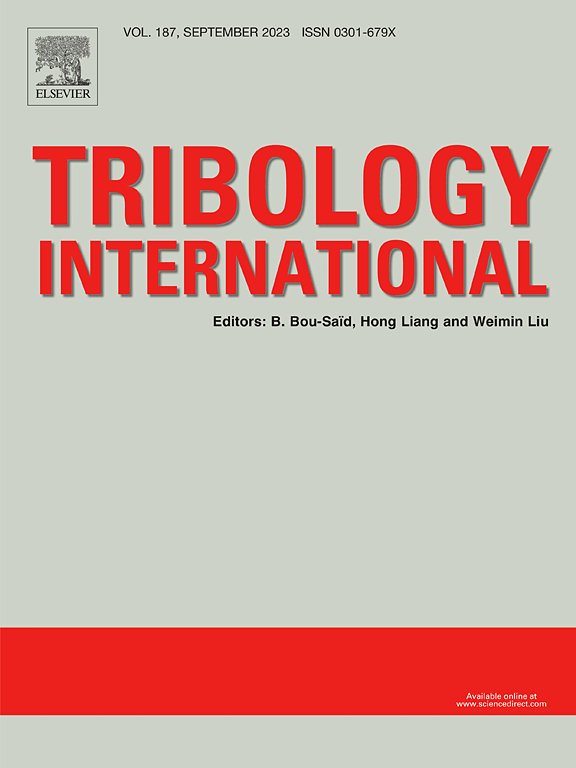Exploring high-temperature short-interval wear property of Fe-Cr-C-Si layers via hardfacing technology and followed laser heat treatment
IF 6.1
1区 工程技术
Q1 ENGINEERING, MECHANICAL
引用次数: 0
Abstract
This study presents an integrated fabrication of Fe-Cr-C-Si hardfacing layers through gas metal arc welding (GMAW) coupled with a subsequent two-step laser heat treatment process, encompassing water cooling post-laser treatment and air cooling, followed by a systematic investigation of their intermittent wear behavior under varying temperature conditions. This finding underscores the remarkable bonding strength and intricate microstructural features of the Fe-Cr-C-Si hardfacing layers, which are further refined through laser heat treatment (LHT), resulting in heightened hardness. Comprehensive wear testing, conducted at two modes and different temperatures, unveils distinct Coefficient of Friction (COF) profiles, with the SiC counterpart exhibiting exceptional wear resistance. Post-wear analysis of the Fe-Cr-C-Si surfaces illuminates the interplay of tribochemical reactions, adhesion, and abrasion mechanisms. Notably, the wear resistance of hardfacing and LHT are outstanding, manifested by exceptionally low wear loss rates (×10−7). The wear loss rate of hardfacing is 65.7 % (400℃) and 39.71 % (500℃) higher than the wear loss rate of the LHT specimens at different temperatures, a nuanced influence of temperature on oxide composition and wear behavior. At 400°C, an extended running-in period is observed, whereas, at 500°C, substantial Cr2O3 and SiO2 oxides are prominent. Initially, a reduction in oxide debris hints at a shortened running-in phase; however, as the wear intervals extended, debris ejection intensified due to the three-body abrasive effects of oxide fines.
通过堆焊工艺和后续激光热处理研究Fe-Cr-C-Si层的高温短时磨损性能
本研究通过气体金属弧焊(GMAW)和随后的两步激光热处理工艺(包括激光处理后的水冷却和空冷)集成制造了Fe-Cr-C-Si堆焊层,然后系统地研究了它们在不同温度条件下的间歇性磨损行为。这一发现强调了Fe-Cr-C-Si堆焊层显著的结合强度和复杂的微观结构特征,通过激光热处理(LHT)进一步细化,从而提高了硬度。在两种模式和不同温度下进行的综合磨损测试揭示了不同的摩擦系数(COF)曲线,而SiC对应物则表现出优异的耐磨性。Fe-Cr-C-Si表面的磨损后分析阐明了摩擦化学反应、粘附和磨损机制的相互作用。值得注意的是,堆焊和LHT的耐磨性非常出色,表现为极低的磨损损失率(×10−7)。堆焊的磨损损失率分别为65.7 %(400℃)和39.71 %(500℃),高于不同温度下堆焊试样的磨损损失率,表明温度对氧化物组成和磨损行为有细微的影响。在400°C时,磨合期延长,而在500°C时,大量的Cr2O3和SiO2氧化物突出。最初,氧化物碎片的减少表明磨合期缩短;然而,随着磨损间隔的延长,由于氧化颗粒的三体磨蚀作用,碎屑喷射加剧。
本文章由计算机程序翻译,如有差异,请以英文原文为准。
求助全文
约1分钟内获得全文
求助全文
来源期刊

Tribology International
工程技术-工程:机械
CiteScore
10.10
自引率
16.10%
发文量
627
审稿时长
35 days
期刊介绍:
Tribology is the science of rubbing surfaces and contributes to every facet of our everyday life, from live cell friction to engine lubrication and seismology. As such tribology is truly multidisciplinary and this extraordinary breadth of scientific interest is reflected in the scope of Tribology International.
Tribology International seeks to publish original research papers of the highest scientific quality to provide an archival resource for scientists from all backgrounds. Written contributions are invited reporting experimental and modelling studies both in established areas of tribology and emerging fields. Scientific topics include the physics or chemistry of tribo-surfaces, bio-tribology, surface engineering and materials, contact mechanics, nano-tribology, lubricants and hydrodynamic lubrication.
 求助内容:
求助内容: 应助结果提醒方式:
应助结果提醒方式:


